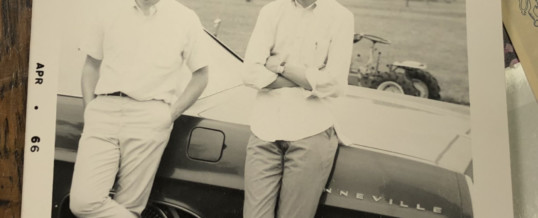
As I sat in Fred’s office listening to him speak, I could hear everything.
It happens that way when Fred is speaking into a sensitive microphone and you’re wearing headphones.
He was reading his new book aloud and I was recording it.
It was his first time to record a book and he trusted me to capture what he was transferring from the written word to the spoken word.
It took four days to record.
My job was to make sure that Fred didn’t miss or fumble a word, and to make sure there wasn’t any extraneous noise that didn’t belong. The end result was something for people to download and listen to as an audio book.
One day we broke for lunch early when someone with a gasoline leaf blower went on an extended cleanup binge somewhere nearby. It was getting into the recording, so we stopped.
I’d met Fred before. Even worked for him on a video project. But I didn’t know him well. During the four days of recording, eating together and sharing stories, I felt we became friends.
While I listened in my headphones and Fred talked, I looked at everything in his office at least 20 times each.
Most interesting to me were the pictures he had under the glass top cover of his round antique table that sat behind his computer chair.
It held pictures from a long range of years of his life.
This impressed me. Most people display the latest photos from life. Fred has many photos from all eras.
The one nearest me that caught my eye was one of him and his best friend at the time. A man named Jay.
In the margins of the photo it read, “Apr 66.”
Fifty-plus years ago, that’s how photos arrived after you shot a roll of film and sent them off for development. It could take weeks for them to be developed and then mailed to you.
A far cry from today’s world where photos are captured in high definition on a cell phone and then can be instantly transmitted to anywhere in the world.
In the photo, Fred and Jay appeared to be about 16. They were leaning against Fred’s dad’s brand new 1966 Pontiac Bonneville convertible.
In that photo, they both had the whole world ahead of them.
Now, decades later, I asked Fred about Jay. Fred said they had found paths that couldn’t have differed more and had lost track of each other. Fred had found the ministry and philanthropy. Jay had lost his way not long after the photo was taken.
As I listened to Fred and watched the recording levels, I kept going back to the month and date on the photo. I thought about the similar photos that my mother had, and possibly still does, that she used to keep in a Pangburn Christmas Candy box.
Most had been taken at family gatherings while I was growing up in Southwest Arkansas. All had the month and date in the margins.
As Fred continued talking and I continued listening, my mind went back to snapshots of my mom’s photos. All with the month and year printed clearly in the periphery of a moment caught in time.
I remembered who was in the photos, what each person was like at the time, and thought of what became of them later.
It occurred to me that in many of the pictures, some of the people were making the most of their life at the time, while others were just existing.
Or, if you will, just marking time in the margins.
I included myself. In many of the photos I remembered, I was not maximizing my life at the time. I was just doing what had to be done to get to the next day, month, or even year.
I can’t recall who said it, but someone once pointed out that the years can be angry.
They are also short. But from the photos under the glass on Fred’s table, he had made most of his count and he was proud of them.
Jay lost his way. At times, so have I. We all have.
But maybe we should put the month and year back on our photos. So that we’re reminded to live life with a serving heart and to its fullest.
And so that we don’t just settle for living within the margins.
©2020 John Moore
John’s book, Write of Passage: A Southerner’s View of Then and Now, and his new book, Write of Passage Volume II, are available on Amazon and on John’s website at www.TheCountryWriter.com.
JAN
2020
